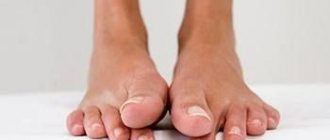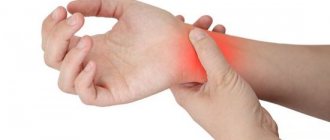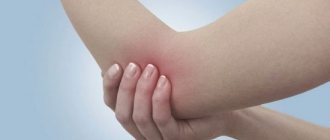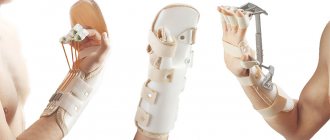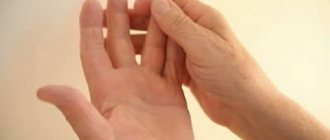The article was prepared by a specialist for informational purposes only. We urge you not to self-medicate. When the first symptoms appear, consult a doctor.
Numbness of the hands and feet often bothers people of all ages. This feeling may be accompanied by tingling, goose bumps, deterioration of sensitivity, and pain. This set of symptoms is called paresthesia. Most often, numbness of the limbs is a physiological phenomenon, that is, harmless. However, sometimes this symptom can indicate serious illness. To find out the cause of regular numbness in your hands, you need to see a doctor.
Causes of numbness
Both physiological and pathological factors can provoke hand numbness.
Temporal or physiological factors
Physiological (temporary) causes of numbness include:
- Spending a long time in a position where one arm is thrown over the armrest. This leads to pressure on the nerve endings, which causes some discomfort.
- Carrying a heavy bag or backpack. In this case, the pressure will be exerted by its straps. Numbness occurs due to impaired blood supply to the limb.
- Wearing clothes that are too tight.
- Frequently raising your arms above your shoulders.
- Spending a long time in the cold. Numbness occurs due to vascular spasm.
All of these factors do not pose any threat to health. To prevent numbness, you need to change your position more often, massage the limb, do light exercises, and change the position of your backpack or bag. The danger comes from pathological causes that lead to numbness in the hands.
Pathological factors
Fingers may become numb due to pinching of nerve endings and blood vessels in the wrist area. Connective tissue can put pressure on them. If the numbness goes away quickly after a change in position, or after rubbing the tissues, then this symptom can be ignored. If numbness occurs frequently, persists for a long time, and it is not possible to cope with it with massage and changing posture, you need to consult a doctor. Such a symptom may indicate pinched nerve fibers or a disruption in the blood supply to tissues.
The reasons can be very serious. Among them:
- Polyneuropathy. This pathology is accompanied by damage to the nerve trunks of the peripheral nervous system. In addition to numbness, the patient will develop weakness in the hands, and their tissues will begin to atrophy, that is, dry out. The patient suffers from cuts (partial impairment of movement). Sometimes paralysis is observed, that is, the functions of the limb will be completely lost. The cause of polyneuropathy may be diabetes mellitus, alcoholism, diphtheria, hemoblastosis, porphyria, periarteritis nodosa, systemic lupus erythematosus.
- Stroke. With this pathology, there is a disruption in the nutrition of the brain. Ischemic stroke most often leads to numbness of the extremities. People's hands go numb at rest, and tingling occurs in them.
- Neuroses.
- Shingles.
- Damage to the nerve nodes of various parts of the spine. The cervical, shoulder, and lumbosacral regions may be affected. With such pathologies, in addition to numbness, a person will suffer from pain. It will be localized in those places for the innervation of which the affected nerve plexuses are responsible. The most common pathology is osteochondrosis.
- Median nerve lesion syndrome. This pathology is called pronator syndrome, carpal tunnel syndrome, etc. Numbness occurs as a “monkey hand”. The surface of the first finger on the palm side and the entire 2, 3 and 4 fingers of the hand suffer.
- Damage to the ulnar and radial nerves, which can be observed with Turner syndrome and other pathologies.
- Vascular damage. Obliterating endarteritis often leads to numbness. With this pathology, microcirculation in small blood vessels is disrupted. This happens against the background of their spasm. Numbness resembles the clinic of osteochondrosis.
- Raynaud's disease. Numbness occurs in the hands and feet. It appears in paroxysms, the cause being a violation of blood circulation in the vessels. Raynaud's disease can be inherited, and severe stress can trigger its manifestation.
- Vitamin deficiency. Numbness develops in people whose bodies lack B vitamins, namely thiamine, folic acid, and cyanocobalamin. Numbness can also develop due to vitamin E deficiency.
- Vibration disease. Numbness is a companion for people who often experience vibrations. In addition to regularly receiving microscopic injuries, such individuals develop pathological reflexes. This causes pain and numbness.
- Injuries received. These could be fractures, bruises, dislocations. All of them contribute to disruption of the integrity of the nerves. This leads to characteristic symptoms.
- Taking certain medications. Numbness appears as a side effect. It is found in antibacterial drugs and chemotherapy agents.
What preventive manipulations can reduce pain?
Numbness of the right hand is much easier to prevent than to treat already in the process. Preventive manipulations include a certain list of procedures, as well as strict control over nutrition. It is important not to worry about trifles and adhere to the right lifestyle. Experts recommend improving the level of blood circulation in the closet section of the spine and preventing further development of acute pathologies and other deformations that may affect the preservation of motor activity.
You can supplement the basic set of activities with certain exercises. So, you need to sit on a chair, grab your shoulders with your hands and begin to perform circular movements with your joints 10 times in one direction and 10 times in the other. After this, you can cross your fingers and place them on the back of your head, keeping your elbows at the same level. After this, you need to bring them together and spread them apart about 15 times each. All exercises are performed slowly and completely relaxed to eliminate the risk of additional joint injury. Some of the preventive manipulations should be done while standing, straightening your back and cervical spine to create the correct body position.
Symptoms
Symptoms of hand numbness largely depend on the exact cause of this disorder.
Common signs of numbness:
- Weakness in limbs.
- Inability to hold an object.
- Tingling sensation in fingers.
- A crawling sensation.
- The appearance of goose bumps.
- Feeling of coldness of the limb.
If after 2-3 minutes the unpleasant symptoms do not go away, then a pathological cause of numbness can be suspected.
When it develops against the background of diabetes mellitus, the patient will experience symptoms such as:
- Numbness in other parts of the body.
- Extreme thirst, dry mouth.
- Frequent urge to empty the bladder.
- Visual impairment.
If a person has diseases of the joints and spine, then in addition to numbness he will be plagued by symptoms such as:
- Pain in the body and limbs.
- Numbness at night. It occurs even if the sleeping position is comfortable.
- Morning stiffness.
- Weak muscle tone.
- Tingling in the palms.
- Numbness of fingers.
When is it necessary to see a doctor?
Numbness as a symptom cannot be ignored. Sometimes it becomes the first sign of the development of a serious disease. Numbness often accompanies a stroke. Therefore, you should not hesitate to contact a specialist. If numbness occurs frequently, you should contact a neurologist.
When to visit a doctor:
- There is no way to explain why the numbness occurs.
- Painful sensations appear in the forearm, fingers, and neck.
- The urge to urinate becomes more frequent.
- A rash appears on the body or limb.
- Numbness is accompanied by dizziness, muscle dysfunction and other symptoms.
- Large areas of the body are involved in the pathological process.
- Numbness is bilateral.
Solutions
Depending on the cause of numbness, treatment of the underlying disease is carried out. Restoration of tissue trophism and resumption of vascular function occurs with the help of physiotherapy. They act on the limbs with ultrasound, electrophoresis, and laser beams. Physical therapy will relieve tissue hypoxia in the hand.
It is necessary to perform gymnastics every day for people in professions that cause tension in the hands and fingers. In the morning, during breaks, in the evening:
- clench and unclench fingers;
- shake with relaxed hands;
- roll a ball or ball between the palms;
- squeeze the massage ball in your hands.
Lifting and lowering the limbs while lying in bed helps restore blood circulation. Manual therapy is effective. Carrying out from 1 to 5 sessions, relieve tension in the cervical and thoracic spine. Acting on certain points of the body, they are relieved of dysfunction of the costovertebral region and shoulder joint.
Which doctor treats hand numbness?
If numbness occurs, you should contact a neurologist. The doctor will examine the patient, clarify his complaints, and evaluate the presence of other neurological signs.
If the doctor deems it necessary, he will refer the patient to other specialized specialists:
- Patients with vasculitis and Raynaud's disease are referred to a rheumatologist.
- People with suspected cardiovascular disease are referred to a cardiologist.
- Patients with diabetes are referred to an endocrinologist.
- Patients with injuries and tumors are referred to a neurosurgeon.
- Patients with infectious diseases are referred to an infectious disease specialist.
- Patients who have been exposed to harmful substances in the workplace are referred to an occupational pathologist.
Diagnosis of the problem
The patient's appointment begins with a questioning, which is of no small importance in diagnostic terms. A thorough medical history allows the doctor to suspect the causes of numbness in the hands. After the interview, the doctor begins to examine the patient. During its implementation, it is important to evaluate skin color, its temperature, tendon reflexes, and skin reflexes.
Based on the data received, the doctor refers the patient for further examination, which may include:
- Donating blood for general and biochemical analysis.
- Submission of urine for general analysis.
- Ultrasound of internal organs.
- X-ray of the skull and spine. The study is prescribed if there is a suspicion of an intervertebral hernia or other disorders of the musculoskeletal system.
- Vascular angiography using contrast.
- CT. This study provides maximum information about the condition of the organs. It can be used to detect hematomas, aneurysms, blood clots, circulatory disorders, etc.
- MRI. It is prescribed when the doctor suspects vascular compression.
- Electroneuromyography. This study allows us to identify innervation disorders. Diagnostics are carried out using special electrodes.
After the patient has completed the necessary tests, the doctor will be able to give him an opinion on his state of health and prescribe appropriate treatment.
Treatment of hand numbness
To cope with numbness in the hands, the doctor prescribes a comprehensive treatment. Therapeutic measures include therapeutic sets of exercises, as well as certain procedures. They are aimed at improving tissue nutrition and increasing blood circulation in the extremities.
Possible treatment options:
- Physiotherapeutic effects on the body: phonophoresis and electrophoresis. Thanks to these procedures, blood flow is activated, so medications penetrate better into damaged tissues.
- Manual therapy. Working out active points allows you to get rid of excess pressure on nerve endings. Muscle spasms go away, joint blockades are removed.
- Exercise therapy. The development of the complex should be carried out by a professional.
Drug treatment
The doctor will be able to select effective medications only after a diagnosis has been made. Medication correction alone is not enough to cope with the problem. It will be necessary not only to take medications, but also to undergo physiotherapeutic measures, exercise therapy, etc.
Drug correction is based on drugs to relieve inflammation. The treatment regimen also includes chondroprotectors, analgesics, and vasodilators.
To improve the condition of nerve fibers and accelerate metabolic processes in nervous tissue, a course of vitamins is recommended: B1, B6 and B12.
Diet therapy
Patients with hand numbness require a diet enriched with vitamins and proteins. Fresh vegetables must be present on the table: cabbage, carrots, herbs, salads. We must not forget about legumes.
You should give up cocoa and coffee. Preference should be given to green tea, herbal drinks, and mint tea.
Meat and fish should not be too fatty. Minimize the consumption of smoked and fried foods. Chicken eggs are eaten 2-3 times a week. The restrictions include cakes and baked goods.
Video: Dr. Evdokimenko, a rheumatologist and psychophysiologist, academician of the Russian Academy of Medical and Technical Sciences, will tell you why your hands or fingers go numb:
Expert advice
If your hand begins to go numb, you should pay attention to your lifestyle and habits. Try to move as much as possible, climb the stairs on foot, without an elevator.
Be sure to do exercises in the morning. You can increase physical activity in other ways, for example, through dancing.
Provide your body with the microelements, vitamins and minerals necessary for its proper functioning. Eat more fruits and vegetables, and periodically take special multivitamin complexes.
Try to always remain calm, no matter the situation. By stopping worrying and getting nervous over trifles, you will soon feel better.


